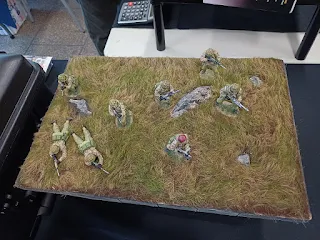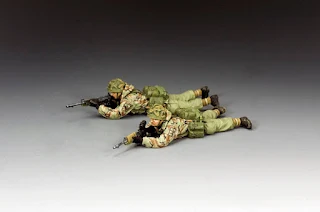This blog page portrays a minimalist diorama (vignette) commemorating the 40th Anniversary (now 41st) of 3 Royal Marine Commando Brigade, and B Squadron, Blues and Royals (Royal Horse Guards). Hopefully a future expansion may include 2 and 3 Battalions The Parachute Regiment, and representation of all other units of the British Military Forces engaged in action in the Falkland Islands, April-June 1982.
Included are a couple of images of the desolate, and hostile environment of the theatre of operations. Miserable, an understatement!
The 1:30 scale armoured vehicle depicted is one of four Scorpion FV101(76mm L23A1) which were deployed. They were accompanied by four Scimitar FV107 (30mm L21 Rarden gun), and additional support vehicles. The figures and the newly released light tank (the actual tank weighed only 8 tons; great speed and trafficability) are produced by Andy Neilson's King and Country Military Miniatures.
In the background of some of the shots can be seen the miniature full band of The Parachute Regiment marching out of their Aldershot depot playing "Don't Cry for Me Argentina". This actually occurred (have the tape). An identical set was presented to Prime Minister Margaret Thatcher. Have copy of her thank you note in 1984 to D.J. Cross, the maker.
What also may be of interest is the accurate corrected historical account of the Royal Marines action at Government House in Stanley at the onset of hostilities on 2 April 1982.
The secret battle of the Falklands War you have never heard about; the Real First Battle of Stanley (Argentine Invasion of the Falkland Islands).
By Gayle_Herald | Posted: June 14, 2017
By Ricky D Phillips
This is the untold story of a 'secret battle' fought during the Falklands war, according to one military historian.
Author Ricky D Phillips says the Battle of Stanley has been ignored in the history books and is calling for the men who fought in it to receive the recognition they deserve.
On the 35th anniversary of the conflict, he shares his account of what really happened.
On April 2, 1982, 60 Royal Marines of the Naval Party 8901 who constituted the entire garrison for the Falkland Islands were overwhelmed by 80 Argentine Commandos.
They put up a mere token defence, fired off a few shots, killed one Argentine and wounded a few more and then surrendered.
That's the story you are supposed to know. It is the story that we – the British public – were all told.
It is the story you will find in every book and on every website which deals with the Falklands War. It is a story which has stood for 35 years as 'established history'.
That story, might I say, is rubbish.
For the first time in 35 years, the accounts of the people involved from all three sides; British, Argentine and the Falkland Islanders themselves have been taken, analysed and formed into a new history with fresh interviews and in-depth research into each and every claim or quote, creating a panoramic view of a battle which we’re all told never happened.
The battle of Stanley - for it was a battle, not a mere skirmish – was an action on a par with Rorke's Drift, a battle which, had the world known the truth, might have cost the UK the entire Falklands War.
At 06.05 the battle opened with 84 Argentine Commandos attacking the British position from the rear.
The night sky lit up as Moody Brook barracks, the Marines' accommodation block outside of town was torn apart by gunfire and grenades only for the Argentine Commandos to find their bunks empty and the Royal Marines already deployed.
Moments later, the first Argentine casualties came when a landing craft with 40 men on board sailed through the narrow strip of water into Stanley Harbour and was destroyed, overturned and sunk with an anti-tank rocket, the tightly-packed men being plunged into the freezing, sucking waters from which none came up again.
At Government House, the seat of government in the islands, a special snatch-squad raced into the grounds to seize the governor Rex Hunt, only to run into four waiting Marines who gunned down three of them and left them lying in the garden.
Now others came, rushing in four-abreast and making easy targets for the Royal Marines who, crouched behind a stone wall, picked them off at will.
"The words 'turkey shoot' flashed through my mind," said one of the defenders, Jim Fairfield.
"We took targets of opportunity. There were a lot of targets and I'm a good shot."
At first light, 21 amphibious armoured personnel carriers, each bearing 28 men, landed on the beach around Stanley airport and raced inland like an iron fist ready to smash the pinned-down Royal Marines, but waiting on the outskirts of town was an anti-tank section who fired rockets at the lead vehicle as it came towards them.
Turning to its right, off the road, the giant 'Amtrac' APC seemed to become stuck on the bank of the road as the Royal Marines reloaded and determined to take it out; "I said 'Let's get it!' and I fired and hit it," remembered Royal Marine Stephen 'George' Brown.
"I know exactly where I hit it… there was a flash and then the smoke started to come out as she brewed up."
Marines Reynolds and Gibbs also fired at it with their own weapons from out on the flank.
Gibbs said: "I definitely hit it about three-quarters of the way up and along. It rocked on its suspension and blew a huge great cloud of black smoke and then died."
Coming to its aid were several more Amtracs, the lead one of which was peppered with machine gun fire, taking out the gunner's scopes as the Royal Marines deployed smoke and pulled out just as the Argentine artillery zeroed their position.
Nobody emerged from the destroyed Amtrac.
Back at Government House, the Argentine forces had pulled back to a nearby rocky ridge, waiting for their armour to come to their aid as the Marines now engaged them in a sniping contest, with Geordie Gill, the Royal Marines' top sniper taking out a section leader, a rifleman and a machine gunner as Corporal Terry Pares beside him took out a radio operator.
Marine Graham Evans said: "At one stage we were in the 11-5 club.
"Eleven wounded and five killed as we were hitting them hard up there on the ridge."
Meanwhile, in the streets of Stanley, several sections of Marines fought running battles with the Argentines, vaulting fences, ploughing through gardens and taking down the enemy who seemed to pop up from everywhere.
One Stanley resident, who later found Argentine bodies in her garden, said: "They were fighting like lions to protect us.
"I never knew our Marines could fight so hard."
Finally, with Argentine forces surrounding them by the thousand, the Falklands' governor Rex Hunt agreed to talk to the Argentine commander, Admiral Busser.
He knew that his Marines could – and would - fight to the finish, and so he had to make a decision.
Looking at his officers, Majors Norman and Nott he ordered them to "Tell your men to stop fighting and to lay down their arms".
Later, in an interview with the Plymouth Herald, he said: "I didn't use the word 'surrender' because I knew it wasn't in the Marines' vocabulary."
It had been an epic defence but sadly an inconvenient one.
With the UK needing to look like it was taken by surprise and stomped over by a fascist junta – a necessary story if the world was to be on our side – the men and their story were denied.
Five military medals and 12 mentions in dispatches were recommended and even approved, none were granted.
When the people of the Falklands – knowing the true story – proposed to grant their own medal, the UK government silenced them.
Hoping that a bare minimum report of five enemy killed, 17 wounded, three prisoners and of course the destroyed Amtrac (only what they physically saw and could confirm) would at least be believed, Major Norman put this in his official report.
It was never published.
(Editorial Note: Roy, it sounds a lot more consistent with the defense Lt Keith Mills and his detachment of 22 Royal Marines put up on South Georgia Island. Also consider that the lead attack elements were comprised of the “elite” Buzo Tactico and 2nd Marine Infantry Battalion.)
(An additional significant Editorial Note: At the most recent annual London Toy Soldier Show ( December 2023) Andy Neilson of King and Country Toy Soldiers, displayed a preview of 8 new Falkland British Parachute Regiment figures. They include LtCol "H" Jones, VC, and have been released in January 2024).






















